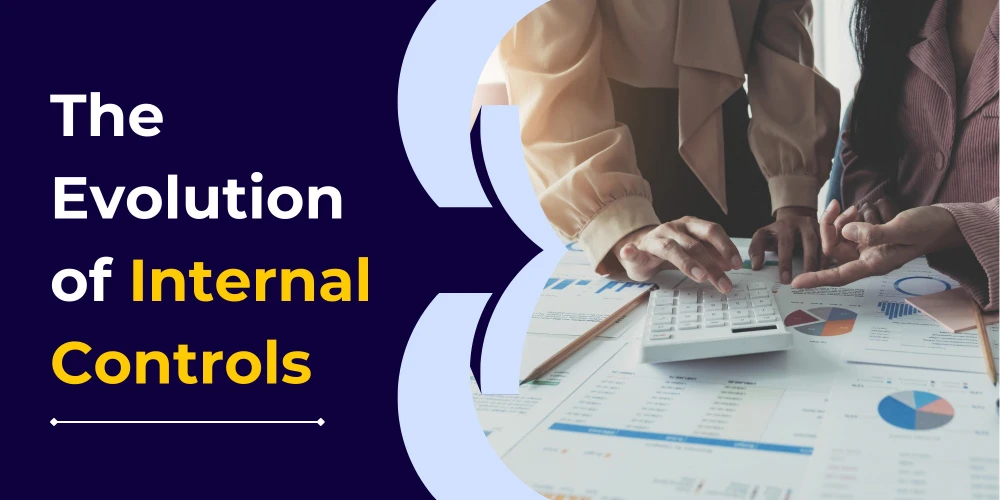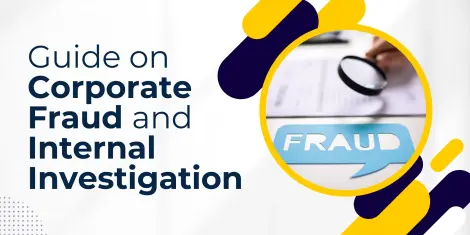Table of Contents
As organizations face mounting regulatory pressures, technological disruption, and stakeholder demands, the evolution of internal controls has transformed from simple checks and balances into sophisticated systems that drive organizational performance. Organizations that master this transformation gain a significant competitive advantage, turning what was once viewed as bureaucratic overhead into a catalyst for efficiency and growth. From preventing the financial scandals of the past to enabling real-time decision-making today, internal controls have become the backbone of operational success. Understanding this evolution is crucial for business leaders who must balance risk management with operational agility while navigating increasingly complex global markets and technological disruption.
What are Internal Controls?
Internal controls represent the vital mechanisms, rules, and procedures that organizations implement to protect assets, ensure reliable financial reporting, and drive operational excellence. At their core, these controls serve as an organization's immune system - detecting, preventing, and correcting operational inefficiencies and risks before they can impact business performance.
Effective internal controls operate across three critical dimensions:
- Preventive Controls: Acting as the first line of defense, these proactive measures stop errors and irregularities before they occur. Examples include segregation of duties, proper authorization protocols, and automated system validations.
- Detective Controls: These mechanisms identify discrepancies after transactions occur, such as reconciliations, audits, and variance analysis - enabling quick corrective action and continuous improvement.
- Directive Controls: These controls guide behavior and operations toward desired outcomes through policies, procedures, and training programs.
The COSO Framework, widely recognized as the gold standard, defines five interconnected components:
- Control Environment: Sets the foundation through organizational structure, ethical values, and management's philosophy
- Risk Assessment: Identifies and analyzes relevant risks to achieving objectives
- Control Activities: Specific actions ensuring management directives are carried out
- Information & Communication: Systems that capture and exchange information needed for effective operations
- Monitoring: Ongoing evaluation processes assessing control effectiveness
Modern internal controls extend beyond traditional financial safeguards to encompass:
- Operational Controls: Optimizing resource utilization and process efficiency
- Compliance Controls: Ensuring adherence to laws, regulations, and internal policies
- Strategic Controls: Aligning activities with organizational objectives
- Technology Controls: Managing IT systems, data integrity, and cybersecurity
When properly designed and implemented, internal controls don't just mitigate risks - they enhance decision-making, streamline operations, and create sustainable competitive advantages. They transform from being perceived as bureaucratic obstacles into strategic enablers of business success.
Historical Overview: The Origins of Internal Controls
The foundations of internal controls trace back to ancient civilizations. Mesopotamian merchants developed the first documented control systems, implementing dual-custody arrangements where multiple scribes verified transactions to prevent fraud. The Ancient Egyptians furthered these concepts by establishing quality control measures in their monumental building projects. The Roman Empire's sophisticated treasury controls and public fund management systems laid groundwork for governmental accounting that persists today.
During the Middle Ages, merchants revolutionized financial controls through the introduction of double-entry bookkeeping. This innovation provided a systematic way to track assets, liabilities, and transactions, becoming the cornerstone of modern accounting controls. These developments proved crucial as trade routes expanded and commercial ventures grew more complex.
The Industrial Revolution marked a pivotal transformation in control systems. As factories emerged and operations scaled, businesses needed new mechanisms to manage inventory, worker productivity, and quality control. Railroad companies, facing the challenge of coordinating operations across vast distances, pioneered complex operational controls that would later influence modern corporate structures. The banking sector responded by developing standardized checking systems and account reconciliation procedures to handle increased transaction volumes.
The early 20th century brought scientific management principles, exemplified by Ford Motor Company's revolutionary production controls and quality management systems. However, the 1929 Wall Street Crash exposed the dangers of inadequate financial oversight, leading to the landmark Securities Acts of 1933 and 1934. These regulations established mandatory financial controls for public companies, fundamentally changing corporate governance.
The modern era of internal controls took shape in response to significant corporate scandals. The Foreign Corrupt Practices Act of 1977 mandated robust internal control systems for public companies. The establishment of the COSO framework in 1985 provided organizations with a comprehensive approach to internal control implementation. Meanwhile, Japanese manufacturers' emphasis on Total Quality Management introduced new perspectives on operational controls and continuous improvement.
The turn of the millennium brought unprecedented challenges and changes. The Sarbanes-Oxley Act of 2002, enacted in response to major corporate scandals, fundamentally transformed control requirements for public companies. The 2008 global financial crisis further highlighted the critical importance of risk management and control systems. Today, digital transformation enables sophisticated real-time monitoring and predictive control capabilities, while increasing cybersecurity risks demand new forms of technology controls.
The Role of Technology in Modern Internal Controls
The digital transformation has fundamentally reshaped how organizations implement and leverage internal controls. Cloud computing, artificial intelligence, and advanced analytics have revolutionized control mechanisms, enabling real-time monitoring, predictive risk assessment, and automated compliance processes that were unimaginable just decades ago.
Automation and Artificial Intelligence
Automation stands at the forefront of this technological revolution. Modern enterprise systems now automatically enforce segregation of duties, validate transactions, and flag anomalies without human intervention. Machine learning algorithms analyze patterns in financial and operational data, identifying potential risks or fraudulent activities before they materialize. These capabilities not only strengthen control effectiveness but also reduce the resource burden of compliance activities.
Advanced Analytics and Real-time Monitoring
Data analytics has transformed control monitoring and testing. Advanced visualization tools provide management with real-time dashboards of key control metrics, enabling faster decision-making and more proactive risk management. Continuous control monitoring systems now scan millions of transactions instantaneously, replacing traditional sample-based testing approaches with comprehensive coverage.
Emerging Technologies and Future Implications
Blockchain technology introduces new possibilities for immutable audit trails and automated verification processes. Smart contracts enable self-executing controls that enforce compliance with predetermined rules and procedures. Meanwhile, robotic process automation (RPA) handles routine control activities, reducing human error and freeing staff for more strategic tasks.
Impact of Internal Controls on Operational Efficiencies
While traditionally viewed as compliance mechanisms, well-designed internal controls have become powerful drivers of operational excellence. Their impact extends far beyond risk mitigation, fundamentally improving how organizations execute their core business processes and deliver value to stakeholders. These include:
Process Excellence and Standardization
Process standardization, a key component of internal controls, eliminates unnecessary variations in operations, reducing errors and improving output quality. By establishing clear procedures and accountability mechanisms, organizations achieve consistent performance across different locations and departments. This standardization also facilitates knowledge transfer and enables rapid scaling of operations.
Resource Management and Optimization
Resource optimization emerges as another crucial benefit. Controls that monitor resource allocation and utilization help organizations identify inefficiencies and reduce waste. Performance measurement controls provide valuable insights into productivity trends, enabling data-driven decisions about resource deployment and process improvements.
Strategic Alignment and Decision Support
Strategic alignment represents perhaps the most significant impact. Modern control systems ensure that operational activities remain aligned with organizational objectives. They provide mechanisms for tracking progress against strategic goals and adjusting course when necessary. This alignment extends to risk management, ensuring that organizations take calculated risks while maintaining operational stability.
Performance Enhancement and Decision Making
Enhanced decision-making capabilities result from robust control systems. By providing reliable, timely information about operational performance, controls enable managers to make more informed decisions. The integration of operational and financial controls offers a comprehensive view of organizational performance, supporting better strategic planning and execution.
Challenges and Limitations of Internal Controls
Cost considerations often present the most immediate challenge. Implementing and maintaining comprehensive control systems requires substantial investment in technology, training, and personnel. Organizations must carefully balance control benefits against their costs, particularly in resource-constrained environments. This challenge becomes more acute as regulatory requirements grow more complex and technological solutions more sophisticated.
Human and Cultural Dimensions
Human factors continue to influence control effectiveness. Even the most well-designed controls can be circumvented through collusion or management override. Employee resistance to control measures can undermine their effectiveness, particularly when controls are perceived as obstacles to productivity. Cultural differences in multinational organizations can also affect how controls are interpreted and implemented across different regions.
Adaptability in Dynamic Environments
Rapid change in business environments creates another significant challenge. Traditional control frameworks may struggle to adapt to new business models, emerging technologies, and evolving risks. The acceleration of digital transformation has introduced new vulnerabilities, particularly in cybersecurity and data privacy, that existing controls may not adequately address.
Organizational Complexity
Complexity management presents ongoing challenges. As organizations grow and operations become more sophisticated, maintaining effective controls becomes increasingly difficult. The interdependencies between different control systems can create unexpected vulnerabilities, while excessive controls can lead to bureaucratic inefficiencies that hamper business agility.
Global Integration Challenges
Control alignment across diverse organizational structures poses particular challenges for global organizations. Different regulatory requirements, business practices, and cultural norms across jurisdictions can complicate the implementation of standardized control frameworks. Additionally, emerging business models, such as platform economies and virtual organizations, challenge traditional control assumptions and require new approaches.
Risk of Control Complacency
False security remains a persistent risk. Organizations may develop a false sense of security from their control systems, overlooking emerging risks or failing to adapt to changing circumstances. Over-reliance on automated controls without adequate human oversight can create blind spots in risk management and decision-making processes.
Future Trends in Internal Controls and Operational Efficiency
The future of internal controls is rapidly evolving, driven by technological innovation and changing business landscapes. Artificial Intelligence and Machine Learning will move beyond anomaly detection to predictive risk management, anticipating control failures before they occur. These systems will leverage vast datasets to continuously learn and adapt, creating dynamic control environments that automatically adjust to emerging risks and operational changes.
Environmental, Social, and Governance (ESG) controls will become increasingly central to operational frameworks as organizations face growing pressure to demonstrate sustainable and responsible business practices. These controls will extend beyond compliance to actively drive operational efficiencies in resource utilization and social impact measurement. Advanced ESG analytics will enable organizations to quantify and optimize their environmental footprint while ensuring social responsibility across their value chains.
The integration of Internet of Things (IoT) sensors and edge computing will transform operational controls, enabling real-time monitoring and automated responses at unprecedented granular levels. Smart contracts and distributed ledger technologies will revolutionize transaction-based controls, creating tamper-proof audit trails and automated compliance verification. These technologies will significantly reduce the cost and complexity of control maintenance while improving their effectiveness.
Remote work and distributed operations will necessitate new approaches to control implementation. Zero-trust architectures and context-aware security controls will become standard, while collaborative platforms will incorporate embedded controls that maintain security and compliance without impeding productivity. Advanced visualization tools and augmented reality interfaces will emerge as key enablers for control monitoring and risk assessment in virtual environments.
Quantum computing, while still emerging, promises to revolutionize cryptographic controls and risk modeling capabilities. Organizations will need to prepare for quantum-resistant security measures while exploring the potential of quantum algorithms to process complex risk scenarios and optimize control frameworks. This technological leap will enable more sophisticated predictive modeling and real-time risk assessment capabilities.
Conclusion
As organizations navigate increasingly complex operational environments, the evolution of internal controls from mere compliance mechanisms to strategic enablers of operational excellence becomes crucial. NSKT's comprehensive approach to internal control implementation combines cutting-edge technology with deep domain expertise, enabling organizations to transform their control frameworks into powerful drivers of operational efficiency. By leveraging advanced analytics, automation, and predictive capabilities, NSKT helps organizations build resilient, adaptive control systems that not only protect assets and ensure compliance but also optimize processes, enhance decision-making, and create sustainable competitive advantages in an increasingly dynamic business landscape.









